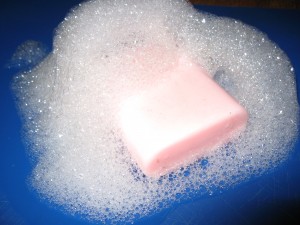Soap making results from the saponification chemical reaction which occurs when caustic alkali (lye water mixture) – either sodium hydroxide, NaOH (also known as caustic soda) or potassium hydroxide, KOH (also known as potash) – is mixed with animal or vegetable oils or fats. From the reaction between these soap ingredients a new matter is created, SOAP, in which there is no more alkali or oil, but which is made of carboxylate salts (R-CO2-Na), water and glycerin. Glycerin is a by-product of saponification that can be taken away. However it is recommended to keep it in the soap mixture as it brings its moisturising property to soap. To find out the details on how to make soap, follow this link to Soap Making Technique.
Soap is a surface-active product. Carboxylate salts molecules are amphiphilic: they are made of a long chain of atoms, one end of which, negatively polarised, is hydrophilic – attracted by water – while the other end is lipophilic – attracted by fats.
Here is the miracle of soap: the lipophilic end of soap molecule catches fats and pull them from their support, thus cleaning the skin (or any other object to be washed), while the other end is attracted to water. As a result fats caught by the soap molecules are taken away by the rinsing water.
During washing, soap removes fat constituting the hydrolipidic film that covers the skin, protects it and retains its water. Fat is taken away by water along with the dirt contained in it. Therefore washing dries your skin until the hydrolipidic film is restored after several hours. The removal of the protective film by a stripper washing such as the one of commercially produced soaps weakens skin, which, without it protection, is highly exposed to external factors.
A superfatted soap is a soap enriched in fats, such as vegetable oils. The presence of these oils limits the drying up of your skin due to the removal of the natural hydrolipidic film.
